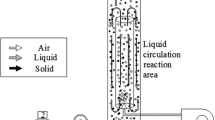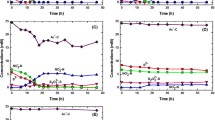Abstract
An autotrophic sulfur oxidizer,Thiobacillus sp. ASWW-2, was isolated from activated sludge, and its sulfur oxidation activity was characterized.Thiobacillus sp. ASWW-2 could oxidize elemental sulfur on the broad range from pH 2 to 8. When 5–50 g/L of elemental sulfur was supplemented as a substrate, the growth and sulfur oxidation activity ofThiobacillus sp. ASWW-2 was not inhibited. The specific sulfur oxidation rate of strain ASWW-2 decreased gradually until sulfate was accumulated in medium up to 10 g/L. In the range of sulfate concentration from 10 g/L to 50 g/L, the sulfur oxidation rate could keep over 2.0 g-S/g-DCW-d. It indicated thatThiobacillus sp. ASWW-2 has tolerance to high concentration of sulfate.
Similar content being viewed by others
References
Eikum, A. S. and R. Storhang (1986) Odour problems related to waste water and sludge treatment. pp. 12–18. In: V. C. Neilsen, J. H. Voorgurg, and P. L. Hermite, (Eds.),Odour Provention and Control of Organic Sludge and Livestock Farming. Elsevier Applied Science Publishers, London.
Yong, Y. and E. R. Allen (1994) Biofiltration control of hydrogen sulfide 1. Design and operational parameters.J. Air Waste Magm. Assoc. 44: 863–868.
Vanhoorne, M., A. Rouck, and D. de. Bacquer (1995) Epidemiological study of eye irritation by hydrogen sulphide and or carbon disulphid exposure in viscose rayon workers.Ann. Occup. Hyg. 39: 307–315.
Mori, T., M. Koga, Y. Hikosaka, T. Nonaka, F. Mishina, Y. Sakai, and J. Koizumi (1991) Microbial corrosion of concrete sewer pipes, H2S production from sediments and determination of corrosion rate.Wat. Sci. Tech., 23: 1275–1282.
Cho, K. S. and T. Mori (1995) A newly isolated fungus participates in the corrosion of concrete sewer pipes.Wat. Sci. Tech. 31: 263–271.
Shoda, M. (1991) Methods for the biological treatment of exhaust gases in biological degradation of waste. pp. 31–46. In: A. M. Martin (ed.),Biological Degradation of Wastes. Elsevier Applied Science Publishers, London.
Cho, K. S., L. Zhang, M. Hirai and M. Shoda (1991) Removal characteristics of hydrogen sulfide and methanethiol byThiobacillus sp. isolated from peat in biological deodorization.J Ferment. Bioeng. 71: 44–49.
Rands M. B., D. E. Cooper, C. P. Woo, G. C. Fletcher, and K. A. Rolfe (1981) Compost filters for H2S removal from anaerobio digestion and rendering exhausts.J. Water Pollut. Control Fed. 53: 185–189.
Cho, K. S., M. Hirai and M. Shoda (1991) Degradation characteristics of hydrogen sulfide, methanethiol, dimethyl sulfide and dimethyl disulfide byThiobacillus thioparus DW44 isolated from peat biofilter.J. Ferment. Bioeng. 71: 384–339.
Cho, K. S., M. Hirai and M. Shoda (1992) Enhanced removal efficiency of malodorous gases in a pilot-scale peat biofilter inoculate withThiobacillus thioparus DW44.J. Ferment. Bioeng. 73: 46–50.
Sublette, K. L. and N. D. Sylvesten (1987) Oxidation of hydrogen sulfide byThiobacillus denitrificans: desulfurization of natural gas.Biotechnol Bioeng. 29: 249–257.
Kanagawa, T. and E. Mikami (1989) Removal of methanethiol. dimethyl sulfide, dimethyl disulfide, and hydrogen sulfide from contaminated air byThiobacillus thioparus TK-m.Appl. Environ. Microbiol. 55: 555–558.
Chung, Y. C., C. Huang and C. F. Li (1997) Removal characteristics of H2S byThiobacillus novellus CH13 biofilter in autotrophic and mixotrophic environments.J. Environ. Sci. Health. A 32: 1435–1450.
Larkin, J. M. (1980) Isolation ofThiotrix in pure culture and observation of a filamentous epiphyte onThiotrix.Curr. Microbiol. 4: 144–158.
Nelson, D. C. and H. W. Jannasch (1983) Chemoautotrophic growth of a marineBeggiatoa in sulfide-gradient cultures.Arch. Microbiol. 136: 262–269.
Zhang, L., M. Hirai and M. Shoda (1991) Removal characteristics of dimethyl sulfide methanethiol and hydrogen sulfide byHyphomicrobium sp. 155 isolated from peat biofilter.J. Ferment. Bioeng. 72: 392–396.
Steinmetz, M. A. and U. Fisher (1982) Cytochromes of the green sulfur bacteriumChlorobium vibrioformef. thiosulfatophilum. Purification, characterization and sulfur metabolism.Arch. Microbiol. 131: 19–26.
Gray, G. O. and J. G. Knaff (1982) The role of a cytochromec-552-cytochromec complex in the oxidation sulfide inChromatium vinosum.Biochim. Biophys. Acta 680: 290–296.
Then, J. and H. G. Truper (1983) Sulfide oxidation inEctothiorhodospira abdelmalekii. Evidence for the catalytic role of cytochromec-551.Arch. Microbiol. 135: 254–258.
Brume, D. C. and H. G. Truper (1986) Noncyclic electron transport in chromatophores from photolithotrophically grownRhodobacter sulfidophilis.Arch. Microbiol. 145: 295–301.
Chung, Y. C., C. Huang and C. P. Tseng (1996) Biodegradation of hydrogen sulfide by a laboratory-scale immobilizedPseudomonas putida CH11 biofilter.Biotechnol. Prog. 12: 773–778.
Cho, K. S., M. Hirai and M. Shoda (1992) Degradation of hydrogen sulfide byXanthomonas sp. strain DY44 isolated from peat.Appl. Environ. Microbiol. 58: 1183–1189.
Kelly, D. P. (1985) Thysiology of the thiobacilli: elucdating the sulphur oxidation pathway.Microbiol. Sci. 2: 105–109.
Kuenen, J. C. (1989) Colorless sulfur bacteria, pp. 1834–1871. In: J. T. Staley, M. P. Bryant, N. Pfenning, and J. G. Holt, (eds.),Bergey’s Manual of Systematic Bacteriology, Vol. 3, The Williams Wilkins Co., Baltimore.
Katayama-F., Y., N. Tsuzaki and H. Kuraishi (1982) Ubiquinone, fatty acid and DNA base composition determination as a guide to the taxonomy of the genusThiobacillus.J. Gen. Microbiol. 128: 1599–1611.
Takakuwa, S., T. Fujimori and H. Iwasaki (1979) Some properties of cell sulfur adhesion inThiobacillus thiooxidans.J. Gen. Appl. Microbiol. 25: 21–29.
Takeuchi, T. L. and I. Suzuki (1997) Cell hydrophobicity and sulfur adhesion ofThiobacillus thiooxidans.,Appl. Environ. Microbiol. 63: 2058–2061.
Konishi, Y., S. Asai and N. Yoshida (1995) Growth kinetics ofThiobacillus thiooxidans on the surface of elemental sulfur.App. Environ. Microb. 61: 3617–3622.
Porro, S., S. Ramirez, C. Reche, C. Curutchet, A. Alonso-Romanowski, E. Donati (1997) Bacterial attachment: its role in bioleaching processes.Process Biochem. 32: 573–578
Author information
Authors and Affiliations
Corresponding author
Rights and permissions
About this article
Cite this article
Lee, E.Y., Cho, KS. & Ryu, H.W. Characterization of sulfur oxidation by an autotrophic sulfur oxidizer,Thiobacillus sp. ASWW-2. Biotechnol. Bioprocess Eng. 5, 48–52 (2000). https://doi.org/10.1007/BF02932353
Received:
Accepted:
Issue Date:
DOI: https://doi.org/10.1007/BF02932353




